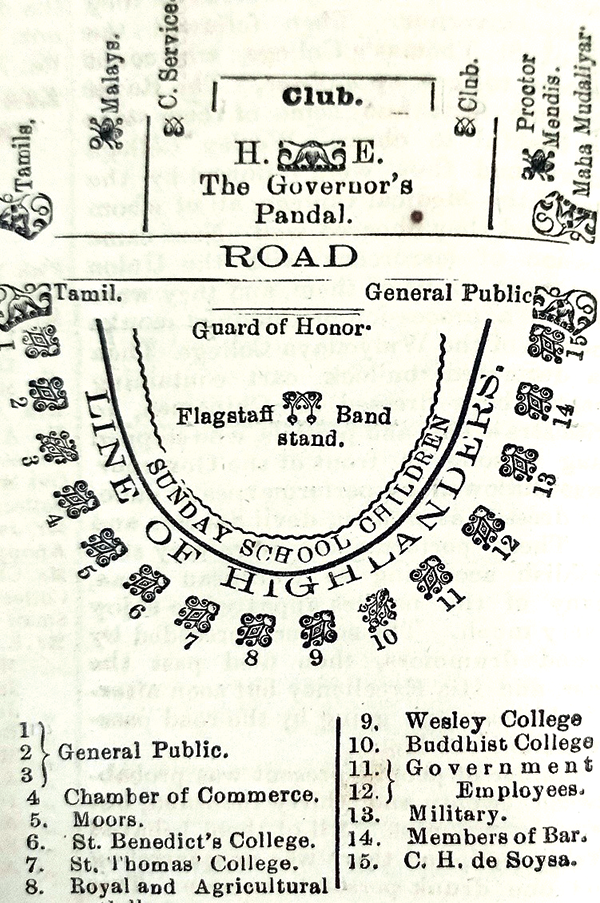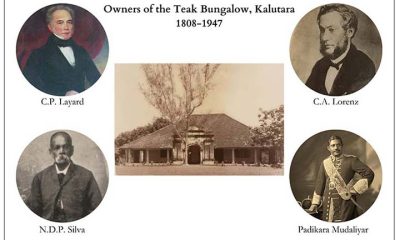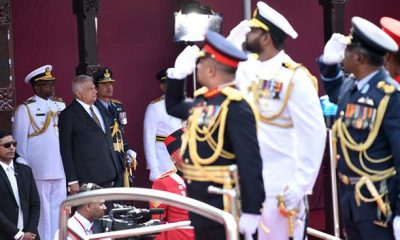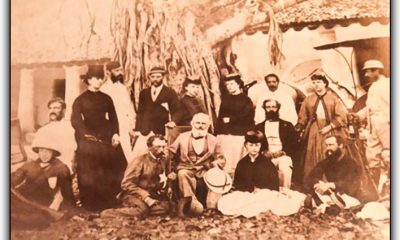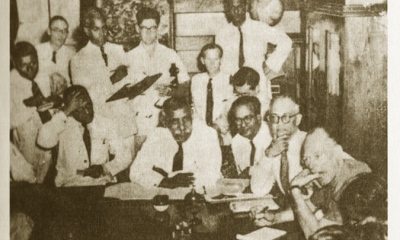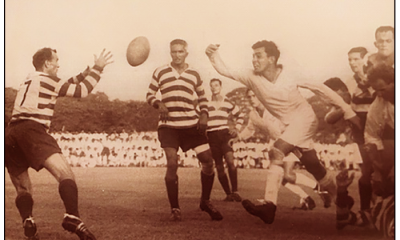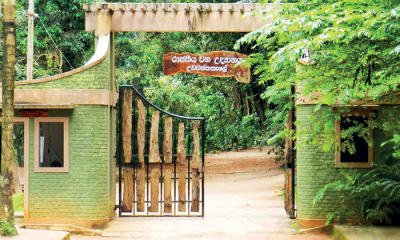Features
When Ceylon celebrated the Golden Jubilee of Queen Victoria
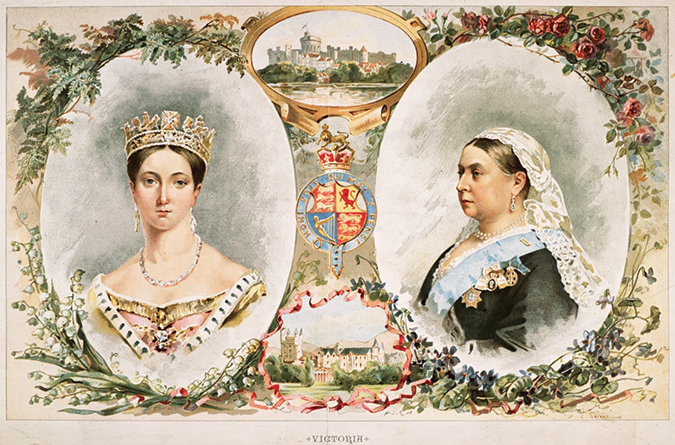
By Avishka Mario Senewiratne and Nilantha Perera
Since the fall of Kandy in 1815, Ceylon significant for its innumerable resources and pivotal geographic location, became a colony of the British. Queen Victoria was British Ceylon’s fourth monarch after George III, George IV, and her uncle William IV. However, unlike her predecessors or successors, the impact Victoria created in Britain and her colonies was so paramount that even her 64-year reign has been dubbed ‘the Victorian Era’.
She is associated with Britain’s great age of industrial expansion, economic progress and especially the territorial expansion of the empire. When Victoria ascended the throne in 1837, Britain was largely a trade power. During her rule Britain became a mighty empire and the world’s most powerful nation. Victoria remained popular in Britain as well as her colonies, throughout her reign. In 1887, the British Empire celebrated Victoria’s Golden Jubilee. Ceylon too, a stronghold of the British Raj celebrated the Queen’s Golden Jubilee with all the pomp and circumstance.
The principal event of the celebrations was to be held at the Galle Face Green on June 28, 1887. Though there were apprehensions that the planned ceremony may be marred by inclement weather, the day went on to be cloudy and breezy, after a short rainfall sparingly enough to polish the floors. This enabled a pleasant show for the outdoor entertainment instead of the usual tropical conditions. The grounds were filled with people of all classes and races, numbering up to around 20-30,000. This is a guesstimate based on what the broadsheets of Colombo reported.
The event began with the Military Review at 7.00 am in front of the Military Hospital and its surroundings. Over 800 commissioned and non-commissioned officers and the Royal Artillery took part in it. With the arrival of Governor Gordon and the Major General, the customary salute and inspection took place. After its completion, the Major General ordered to fire feu-de-joie, which was done in good style. This was followed by three hearty cheers for the Queen by the soldiers.
Next in line was a well planned and well executed march past in quarter column, while drums and bagpipes were played. After the Volunteers left the ground, the Artillerymen and the Highlanders joined in and the Major General presented his address. With a slight drop of rainfall, the spectators believed that the proceedings were wrecked. However, the rain was short lived and hopes were up again.
That afternoon, a number of thanksgiving services were conducted in the leading places of worship in Colombo. Archbishop Bonjean celebrated High Mass at the Kotahena Cathedral, and the singing of Te Deum with Benediction took place at St. Philip Neri’s Church, Pettah. Other services for the Anglicans were held at St. Peter’s Cathedral, for the Presbyterians at St. Andrew’s Church, Wolvendaal church and the Fort Chapel, to name a few.
That evening the principal ceremony took place. The Governor’s Pavilion took centre stage which was located in front of the Colombo Club. Across the road were the other pandals consisting of different schools, nationalities and institutions. Sunday-school children of various protestant faiths, accompanied by teachers were placed in front of the Governor’s pandal with soldiers before and behind them. John Ferguson of the Ceylon Observer commented on the pandals as follows: “Nothing can exceed the graceful beauty of such erections, when the Sinhalese and the Tamils set themselves to do their best; loops of plantain and young coconut leaf, green moss and fern, and yellow olas, and clusters of coconuts, oranges, or other fruits, offer the best possible material for covering the bamboo framework that may be put together in a night”. Round the foot the flagstaff of the Royal Standard was a raised bandstand which was occupied by the Volunteers’ band under the direction of Ernst Luschwitz.
At 4.00pm Governor Arthur Hamilton-Gordon, arrived in an open carriage accompanied by Maha Mudaliyar Conrad Dias Bandaranaike, Mr. W. M. Gordon, his acting Private Secretary, and Captain Christopher, his Aide-de-Camp. Governor Gordon was received by the Chief Justice, Sir Bruce Burnside and by the members of the Legislative and Executive Councils.
The Governor’s Pavilion was occupied by Archbishop Christopher Bonjean OMI, the Chief Justice and Lady Burnside, Justices L.B. Clarence and Harry Dias Bandaranaike, the Hon. Mr. Rawonseroft, the Anglican Bishop R.S. Copleston, the Director of Public Instruction and Mrs. Green, Dr. William R. Kynsey, Chief Medical Officer of Ceylon, the official and unofficial members of the Legislative Council, the Foreign Consuls, Fr. Dominique Pulicani OMI, the principal Military Officers, and a number of other prominent ladies and gentlemen.
Having taken his place, the Governor readout the record of Her Majesty’s reign and the proclamation to the people of Ceylon. The message was simultaneously read in English, Sinhalese and Tamil in the respective pandals. Governor Gordon made the following three proclamations that day. The first was to thank God for the mercies during her reign and for all her people in the dominion. The second was to restore Crown lands taken during the Grain Commutation Ordinance, back to its former possessors. The third was to give clemency to 137 prisoners who were 1). In prison for debts due to the crown. 2). All women who were not undergoing imprisonment for very serious offences. 3). Prisoners whose sentences of imprisonment are shortly to expire. The Royal Standard was then run up and a salute of 50 guns were fired followed by the national anthem “God Save the Queen”.
Thereafter, a large procession was followed. The order of the procession was as follows:
· The Sunday school students, accompanied by their teachers.
· Malays preceded by a decorated bullock cart containing a party of Malay singers.
· Orabi Pasha, the famed Egyptian exiled in Ceylon, and suite followed, giving the Governor a military salute in passing and they were followed by a procession of Moor men.
· Students of St. Benedict’s Institute, accompanied by some of the Christian Brothers.
· Students of S. Thomas’s College.
· Students of Royal College.
· Students of Wesley College
· Students of the Medical College, all of whom bore flags.
· Procession of lascoreens with the Union Jack borne in front of them.
· Buddhist monks and students of the Vidyodaya College.
· Decorated bullock cart containing nine native boys dressed as Chinamen in blue with straw hats and pigtails, who stopped and sang a song in front of the Governor.
· Performances of dancing men dressed as women, devil dancers and others.
· The soldiers, preceded by pipers and drummers.
The Ceylon Catholic Messenger of July 1, 1887 commented on the ceremony as follows: “These performances were very silly and childish according to European ideas, but many of the natives appeared to enjoy them very much”. After the procession was over, the Governor left in his carriage, ending the ceremony. The evening was concluded with a fabulous firework display and illuminations, brightening the wide Colombo firmament. The Queen’s House, offices of Volkart Brothers and Aitken Spence & Co., and the Mercantile Bank were illuminated with lanterns creating a beautiful spectacle. Furthermore, the Agency of the French mail steamers presented a fine sight along with the other vessels in the harbour. The Ceylon Examiner commented on the day as follows: “Never did the Galle Face Green look prettier and never did so large an assemblage gather on it.”
On the jubilee day a large number of poor in towns and villages were fed, each getting a measure of rice and five cents (equivalent to one penny). That very year to honour and commemorate Victoria and her 50th year on the throne, the Victoria Park in Nuwara Eliya was built. Victoria would remain on the throne for 14 more years.
What is truly significant about the celebration, which has now been forgotten by many is that it made a striking resemblance to the very first Independence Day celebration in 1948. Many scholars such as Nira Wickramasinghe have stated that this celebration was the script of the celebrations of 1948. There were hardly any changes between the celebration of the monarch who ruled the colony for 50 years and the celebration of being independent of the same colonial power. There existed the same ingredients of the former such as the Military Review, religious ceremonies, speeches and acts of charity.
“Great events make me quiet and calm; it is only trifles that irritate my nerves”
· Queen Victoria References
Times of Ceylon
, 1887 June-July
The Ceylon Catholic Messenger,
1887, June-July
The Ceylon Examiner,
1887, June-July
Ferguson, John, (1887) Ceylon in the Jubilee Year, London & Colombo
Wickramasinghe, Nira, (2006) Sri Lanka in the Modern Age: A History of Contested Identities, London
Features
The heart-friendly health minister

by Dr Gotabhya Ranasinghe
Senior Consultant Cardiologist
National Hospital Sri Lanka
When we sought a meeting with Hon Dr. Ramesh Pathirana, Minister of Health, he graciously cleared his busy schedule to accommodate us. Renowned for his attentive listening and deep understanding, Minister Pathirana is dedicated to advancing the health sector. His openness and transparency exemplify the qualities of an exemplary politician and minister.
Dr. Palitha Mahipala, the current Health Secretary, demonstrates both commendable enthusiasm and unwavering support. This combination of attributes makes him a highly compatible colleague for the esteemed Minister of Health.
Our discussion centered on a project that has been in the works for the past 30 years, one that no other minister had managed to advance.
Minister Pathirana, however, recognized the project’s significance and its potential to revolutionize care for heart patients.
The project involves the construction of a state-of-the-art facility at the premises of the National Hospital Colombo. The project’s location within the premises of the National Hospital underscores its importance and relevance to the healthcare infrastructure of the nation.
This facility will include a cardiology building and a tertiary care center, equipped with the latest technology to handle and treat all types of heart-related conditions and surgeries.
Securing funding was a major milestone for this initiative. Minister Pathirana successfully obtained approval for a $40 billion loan from the Asian Development Bank. With the funding in place, the foundation stone is scheduled to be laid in September this year, and construction will begin in January 2025.
This project guarantees a consistent and uninterrupted supply of stents and related medications for heart patients. As a result, patients will have timely access to essential medical supplies during their treatment and recovery. By securing these critical resources, the project aims to enhance patient outcomes, minimize treatment delays, and maintain the highest standards of cardiac care.
Upon its fruition, this monumental building will serve as a beacon of hope and healing, symbolizing the unwavering dedication to improving patient outcomes and fostering a healthier society.We anticipate a future marked by significant progress and positive outcomes in Sri Lanka’s cardiovascular treatment landscape within the foreseeable timeframe.
Features
A LOVING TRIBUTE TO JESUIT FR. ALOYSIUS PIERIS ON HIS 90th BIRTHDAY

by Fr. Emmanuel Fernando, OMI
Jesuit Fr. Aloysius Pieris (affectionately called Fr. Aloy) celebrated his 90th birthday on April 9, 2024 and I, as the editor of our Oblate Journal, THE MISSIONARY OBLATE had gone to press by that time. Immediately I decided to publish an article, appreciating the untiring selfless services he continues to offer for inter-Faith dialogue, the renewal of the Catholic Church, his concern for the poor and the suffering Sri Lankan masses and to me, the present writer.
It was in 1988, when I was appointed Director of the Oblate Scholastics at Ampitiya by the then Oblate Provincial Fr. Anselm Silva, that I came to know Fr. Aloy more closely. Knowing well his expertise in matters spiritual, theological, Indological and pastoral, and with the collaborative spirit of my companion-formators, our Oblate Scholastics were sent to Tulana, the Research and Encounter Centre, Kelaniya, of which he is the Founder-Director, for ‘exposure-programmes’ on matters spiritual, biblical, theological and pastoral. Some of these dimensions according to my view and that of my companion-formators, were not available at the National Seminary, Ampitiya.
Ever since that time, our Oblate formators/ accompaniers at the Oblate Scholasticate, Ampitiya , have continued to send our Oblate Scholastics to Tulana Centre for deepening their insights and convictions regarding matters needed to serve the people in today’s context. Fr. Aloy also had tried very enthusiastically with the Oblate team headed by Frs. Oswald Firth and Clement Waidyasekara to begin a Theologate, directed by the Religious Congregations in Sri Lanka, for the contextual formation/ accompaniment of their members. It should very well be a desired goal of the Leaders / Provincials of the Religious Congregations.
Besides being a formator/accompanier at the Oblate Scholasticate, I was entrusted also with the task of editing and publishing our Oblate journal, ‘The Missionary Oblate’. To maintain the quality of the journal I continue to depend on Fr. Aloy for his thought-provoking and stimulating articles on Biblical Spirituality, Biblical Theology and Ecclesiology. I am very grateful to him for his generous assistance. Of late, his writings on renewal of the Church, initiated by Pope St. John XX111 and continued by Pope Francis through the Synodal path, published in our Oblate journal, enable our readers to focus their attention also on the needed renewal in the Catholic Church in Sri Lanka. Fr. Aloy appreciated very much the Synodal path adopted by the Jesuit Pope Francis for the renewal of the Church, rooted very much on prayerful discernment. In my Religious and presbyteral life, Fr.Aloy continues to be my spiritual animator / guide and ongoing formator / acccompanier.
Fr. Aloysius Pieris, BA Hons (Lond), LPh (SHC, India), STL (PFT, Naples), PhD (SLU/VC), ThD (Tilburg), D.Ltt (KU), has been one of the eminent Asian theologians well recognized internationally and one who has lectured and held visiting chairs in many universities both in the West and in the East. Many members of Religious Congregations from Asian countries have benefited from his lectures and guidance in the East Asian Pastoral Institute (EAPI) in Manila, Philippines. He had been a Theologian consulted by the Federation of Asian Bishops’ Conferences for many years. During his professorship at the Gregorian University in Rome, he was called to be a member of a special group of advisers on other religions consulted by Pope Paul VI.
Fr. Aloy is the author of more than 30 books and well over 500 Research Papers. Some of his books and articles have been translated and published in several countries. Among those books, one can find the following: 1) The Genesis of an Asian Theology of Liberation (An Autobiographical Excursus on the Art of Theologising in Asia, 2) An Asian Theology of Liberation, 3) Providential Timeliness of Vatican 11 (a long-overdue halt to a scandalous millennium, 4) Give Vatican 11 a chance, 5) Leadership in the Church, 6) Relishing our faith in working for justice (Themes for study and discussion), 7) A Message meant mainly, not exclusively for Jesuits (Background information necessary for helping Francis renew the Church), 8) Lent in Lanka (Reflections and Resolutions, 9) Love meets wisdom (A Christian Experience of Buddhism, 10) Fire and Water 11) God’s Reign for God’s poor, 12) Our Unhiddden Agenda (How we Jesuits work, pray and form our men). He is also the Editor of two journals, Vagdevi, Journal of Religious Reflection and Dialogue, New Series.
Fr. Aloy has a BA in Pali and Sanskrit from the University of London and a Ph.D in Buddhist Philosophy from the University of Sri Lankan, Vidyodaya Campus. On Nov. 23, 2019, he was awarded the prestigious honorary Doctorate of Literature (D.Litt) by the Chancellor of the University of Kelaniya, the Most Venerable Welamitiyawe Dharmakirthi Sri Kusala Dhamma Thera.
Fr. Aloy continues to be a promoter of Gospel values and virtues. Justice as a constitutive dimension of love and social concern for the downtrodden masses are very much noted in his life and work. He had very much appreciated the commitment of the late Fr. Joseph (Joe) Fernando, the National Director of the Social and Economic Centre (SEDEC) for the poor.
In Sri Lanka, a few religious Congregations – the Good Shepherd Sisters, the Christian Brothers, the Marist Brothers and the Oblates – have invited him to animate their members especially during their Provincial Congresses, Chapters and International Conferences. The mainline Christian Churches also have sought his advice and followed his seminars. I, for one, regret very much, that the Sri Lankan authorities of the Catholic Church –today’s Hierarchy—- have not sought Fr.
Aloy’s expertise for the renewal of the Catholic Church in Sri Lanka and thus have not benefited from the immense store of wisdom and insight that he can offer to our local Church while the Sri Lankan bishops who governed the Catholic church in the immediate aftermath of the Second Vatican Council (Edmund Fernando OMI, Anthony de Saram, Leo Nanayakkara OSB, Frank Marcus Fernando, Paul Perera,) visited him and consulted him on many matters. Among the Tamil Bishops, Bishop Rayappu Joseph was keeping close contact with him and Bishop J. Deogupillai hosted him and his team visiting him after the horrible Black July massacre of Tamils.
Features
A fairy tale, success or debacle

Sri Lanka-Singapore Free Trade Agreement
By Gomi Senadhira
senadhiragomi@gmail.com
“You might tell fairy tales, but the progress of a country cannot be achieved through such narratives. A country cannot be developed by making false promises. The country moved backward because of the electoral promises made by political parties throughout time. We have witnessed that the ultimate result of this is the country becoming bankrupt. Unfortunately, many segments of the population have not come to realize this yet.” – President Ranil Wickremesinghe, 2024 Budget speech
Any Sri Lankan would agree with the above words of President Wickremesinghe on the false promises our politicians and officials make and the fairy tales they narrate which bankrupted this country. So, to understand this, let’s look at one such fairy tale with lots of false promises; Ranil Wickremesinghe’s greatest achievement in the area of international trade and investment promotion during the Yahapalana period, Sri Lanka-Singapore Free Trade Agreement (SLSFTA).
It is appropriate and timely to do it now as Finance Minister Wickremesinghe has just presented to parliament a bill on the National Policy on Economic Transformation which includes the establishment of an Office for International Trade and the Sri Lanka Institute of Economics and International Trade.
Was SLSFTA a “Cleverly negotiated Free Trade Agreement” as stated by the (former) Minister of Development Strategies and International Trade Malik Samarawickrama during the Parliamentary Debate on the SLSFTA in July 2018, or a colossal blunder covered up with lies, false promises, and fairy tales? After SLSFTA was signed there were a number of fairy tales published on this agreement by the Ministry of Development Strategies and International, Institute of Policy Studies, and others.
However, for this article, I would like to limit my comments to the speech by Minister Samarawickrama during the Parliamentary Debate, and the two most important areas in the agreement which were covered up with lies, fairy tales, and false promises, namely: revenue loss for Sri Lanka and Investment from Singapore. On the other important area, “Waste products dumping” I do not want to comment here as I have written extensively on the issue.
1. The revenue loss
During the Parliamentary Debate in July 2018, Minister Samarawickrama stated “…. let me reiterate that this FTA with Singapore has been very cleverly negotiated by us…. The liberalisation programme under this FTA has been carefully designed to have the least impact on domestic industry and revenue collection. We have included all revenue sensitive items in the negative list of items which will not be subject to removal of tariff. Therefore, 97.8% revenue from Customs duty is protected. Our tariff liberalisation will take place over a period of 12-15 years! In fact, the revenue earned through tariffs on goods imported from Singapore last year was Rs. 35 billion.
The revenue loss for over the next 15 years due to the FTA is only Rs. 733 million– which when annualised, on average, is just Rs. 51 million. That is just 0.14% per year! So anyone who claims the Singapore FTA causes revenue loss to the Government cannot do basic arithmetic! Mr. Speaker, in conclusion, I call on my fellow members of this House – don’t mislead the public with baseless criticism that is not grounded in facts. Don’t look at petty politics and use these issues for your own political survival.”
I was surprised to read the minister’s speech because an article published in January 2018 in “The Straits Times“, based on information released by the Singaporean Negotiators stated, “…. With the FTA, tariff savings for Singapore exports are estimated to hit $10 million annually“.
As the annual tariff savings (that is the revenue loss for Sri Lanka) calculated by the Singaporean Negotiators, Singaporean $ 10 million (Sri Lankan rupees 1,200 million in 2018) was way above the rupees’ 733 million revenue loss for 15 years estimated by the Sri Lankan negotiators, it was clear to any observer that one of the parties to the agreement had not done the basic arithmetic!
Six years later, according to a report published by “The Morning” newspaper, speaking at the Committee on Public Finance (COPF) on 7th May 2024, Mr Samarawickrama’s chief trade negotiator K.J. Weerasinghehad had admitted “…. that forecasted revenue loss for the Government of Sri Lanka through the Singapore FTA is Rs. 450 million in 2023 and Rs. 1.3 billion in 2024.”
If these numbers are correct, as tariff liberalisation under the SLSFTA has just started, we will pass Rs 2 billion very soon. Then, the question is how Sri Lanka’s trade negotiators made such a colossal blunder. Didn’t they do their basic arithmetic? If they didn’t know how to do basic arithmetic they should have at least done their basic readings. For example, the headline of the article published in The Straits Times in January 2018 was “Singapore, Sri Lanka sign FTA, annual savings of $10m expected”.
Anyway, as Sri Lanka’s chief negotiator reiterated at the COPF meeting that “…. since 99% of the tariffs in Singapore have zero rates of duty, Sri Lanka has agreed on 80% tariff liberalisation over a period of 15 years while expecting Singapore investments to address the imbalance in trade,” let’s turn towards investment.
Investment from Singapore
In July 2018, speaking during the Parliamentary Debate on the FTA this is what Minister Malik Samarawickrama stated on investment from Singapore, “Already, thanks to this FTA, in just the past two-and-a-half months since the agreement came into effect we have received a proposal from Singapore for investment amounting to $ 14.8 billion in an oil refinery for export of petroleum products. In addition, we have proposals for a steel manufacturing plant for exports ($ 1 billion investment), flour milling plant ($ 50 million), sugar refinery ($ 200 million). This adds up to more than $ 16.05 billion in the pipeline on these projects alone.
And all of these projects will create thousands of more jobs for our people. In principle approval has already been granted by the BOI and the investors are awaiting the release of land the environmental approvals to commence the project.
I request the Opposition and those with vested interests to change their narrow-minded thinking and join us to develop our country. We must always look at what is best for the whole community, not just the few who may oppose. We owe it to our people to courageously take decisions that will change their lives for the better.”
According to the media report I quoted earlier, speaking at the Committee on Public Finance (COPF) Chief Negotiator Weerasinghe has admitted that Sri Lanka was not happy with overall Singapore investments that have come in the past few years in return for the trade liberalisation under the Singapore-Sri Lanka Free Trade Agreement. He has added that between 2021 and 2023 the total investment from Singapore had been around $162 million!
What happened to those projects worth $16 billion negotiated, thanks to the SLSFTA, in just the two-and-a-half months after the agreement came into effect and approved by the BOI? I do not know about the steel manufacturing plant for exports ($ 1 billion investment), flour milling plant ($ 50 million) and sugar refinery ($ 200 million).
However, story of the multibillion-dollar investment in the Petroleum Refinery unfolded in a manner that would qualify it as the best fairy tale with false promises presented by our politicians and the officials, prior to 2019 elections.
Though many Sri Lankans got to know, through the media which repeatedly highlighted a plethora of issues surrounding the project and the questionable credentials of the Singaporean investor, the construction work on the Mirrijiwela Oil Refinery along with the cement factory began on the24th of March 2019 with a bang and Minister Ranil Wickremesinghe and his ministers along with the foreign and local dignitaries laid the foundation stones.
That was few months before the 2019 Presidential elections. Inaugurating the construction work Prime Minister Ranil Wickremesinghe said the projects will create thousands of job opportunities in the area and surrounding districts.
The oil refinery, which was to be built over 200 acres of land, with the capacity to refine 200,000 barrels of crude oil per day, was to generate US$7 billion of exports and create 1,500 direct and 3,000 indirect jobs. The construction of the refinery was to be completed in 44 months. Four years later, in August 2023 the Cabinet of Ministers approved the proposal presented by President Ranil Wickremesinghe to cancel the agreement with the investors of the refinery as the project has not been implemented! Can they explain to the country how much money was wasted to produce that fairy tale?
It is obvious that the President, ministers, and officials had made huge blunders and had deliberately misled the public and the parliament on the revenue loss and potential investment from SLSFTA with fairy tales and false promises.
As the president himself said, a country cannot be developed by making false promises or with fairy tales and these false promises and fairy tales had bankrupted the country. “Unfortunately, many segments of the population have not come to realize this yet”.
(The writer, a specialist and an activist on trade and development issues . )

